Learning the parts of the face in English is a fundamental step in building vocabulary, especially for children. Knowing these words helps in everyday conversations, understanding descriptions, and even in learning about emotions and expressions. Let’s explore the different parts of the face in English in a fun and easy way!
Key Parts of Your Face in English
Here’s a list of the main parts of your face, with their English names:
- Face: This is the whole front part of your head, from your forehead to your chin.
- Forehead: The top part of your face, above your eyebrows and below your hairline.
- Eyes: We use our eyes to see the world around us. You have two eyes.
- Eyebrows: These are lines of hair above your eyes. They help to show your feelings.
- Eyelashes: These tiny hairs grow at the edge of your eyelids and protect your eyes.
- Nose: You use your nose to smell and to breathe.
- Cheeks: The soft, fleshy parts of your face below your eyes and between your nose and ears.
- Mouth: You use your mouth to eat, speak, and smile.
- Lips: The two soft parts around your mouth opening.
- Teeth: Hard, white things inside your mouth that help you chew food.
- Tongue: The soft, movable part inside your mouth that helps you taste and speak.
- Chin: The bottom part of your face, below your mouth.
- Ears: You use your ears to hear sounds. You have two ears on the sides of your head.
More Facial Features to Learn
Let’s expand our vocabulary with some more detailed parts of the face:
- Pupils: The black circles in the middle of your eyes that let light in so you can see.
- Cheekbones: The bones under your cheeks, that can become more noticeable when you smile.
- Jaw: The bone that forms the lower part of your face and holds your bottom teeth. It moves when you talk or chew.
- Nostrils: The two openings in your nose that you breathe through.
- Earlobe: The soft, fleshy lower part of your ear.
- Hair: While technically not just on your face, your hairstyle frames your face.
- Neck: The part that connects your head to your body, supporting your face.
Practice Sentences Using Face Parts Vocabulary
Let’s use these words in sentences to help you remember them:
- “Touch your forehead.” (Imagine a game where you ask kids to touch different parts of their face)
- “She has beautiful brown eyes.” (Describing someone’s appearance)
- “He raised his eyebrows in surprise.” (Talking about expressions)
- “The flower smells nice, can you smell it with your nose?” (Using senses to learn)
- “Smile and show your teeth!” (Instructions for a photo or action)
- “Point to your chin.” (Simple command for learning)
- “Cover your ears if it gets too loud.” (Safety instruction)
- “My cheeks are rosy when I play outside in the cold.” (Describing physical sensations)
- “Use your lips to say ‘Mmm, delicious!'” (Connecting actions to words)
Why Learning Face Parts is Important for Kids
Knowing the parts of the face in English is more than just vocabulary. It helps children:
- Communicate effectively: They can describe themselves and others, explain how they feel, and understand instructions related to their body.
- Understand stories and songs: Many children’s songs and stories mention face parts.
- Learn about emotions: Facial expressions are key to understanding emotions, and knowing the parts of the face helps in recognizing and talking about feelings.
- Prepare for further learning: This basic vocabulary builds a foundation for learning more complex English and about the human body.
Learning the “parts of the face in English for kids” can be a fun and interactive experience. Use games, songs, and everyday conversations to help children learn and remember these essential words.
